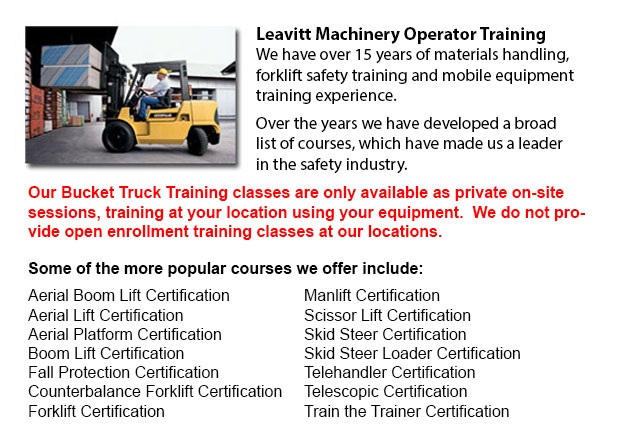
Bucket Truck Training Goodyear - The bucket truck training program is a program which is intended to efficiently train operators who are qualified so they could reduce the chance of personal injury and incident when working in close proximity to or with bucket trucks or likewise referred to as vehicle-mounted aerial work platform. An aerial lift device is any vehicle-mounted device, articulating or telescoping, or both, that is used to position employees to reach places that will otherwise be unreachable. Aerial lift devices are utilized to elevate workers to above-ground work locations.
The objective of the program is to provide operators with the skills, knowledge, abilities, and training materials necessary to learn to operate vehicle-mounted aerial work platforms safely and effectively.
The program has two components: a classroom training session and a hands-on training session. To become certified, participants must be successful in both components. A full-size certificate and a wallet-size certificate will be issued upon finishing the program.
The types of lifts examined in the program include Aerial lift devices are often constructed with metal, wood, fiberglass, reinforced plastic or other materials.
Definitions
Articulating boom platform: many hinged boom parts.
Extensible boom platform: has an extensible or telescopic boom.
Platform: section of the aerial device which is designed to carry employees.
Mobile unit: any aerial device along with its components like for example vehicle and related machinery.
Employers have the responsibility to ensure their worker receive right training prior to operating aerial devices. Employees must make certain they also obtain the required training and that they do not operate lift devices if they are not authorized to do so. Employees must ensure that they wear the right protective equipment while working from the platform.
The course content used in the bucket truck training program consists of the operation of the vehicle-mounted aerial work platform, pre-shift inspections, safe operating practices, use of emergency controls, lifting capacity, and administering theory and practical tests. Operators would be familiar with legal requirements under the federal and local regulations.
-
Crane / Overhead Crane / Truck Mounted Crane / Hydraulic Cranes Training in Goodyear
Bridge cranes or likewise called overhead cranes are a kind of industrial material handling crane making use of a line and hook device that runs on a horizontal beam running along two widely separated rails. Many overhead cranes can be seen inside a... More -
Fantuzzi Parts
The Italian Fantuzzi Group offers a glut of material handling equipment and heavy machinery. The equipment consists of numerous equipment specializing in transporting, loading and unloading goods. The railway freight sector and the port authority req... More -
Forklift Training School Goodyear
Forklift Training School Goodyear - Why A Forklift Training School Could Actually Help A Business And Its Employees - CSA and OSHA establish criteria for forklift safety training that meets existing regulations and standards. Anyone intending to oper... More -
Warehouse Forklift Training Classes Goodyear
Warehouse Forklift Training Classes Goodyear - The purpose of warehouse training classes are to raise the awareness of common workplace hazards. The trainees would learn necessary warehouse safety measures. An emphasis is placed on paying attention t... More -
Aerial Lift Ticket Goodyear
Aerial Lift Ticket Goodyear - A boom truck is frequently recognized by the cable and phone business vehicles that have the long arm folded over their roofs. Usually, a bucket-like apparatus sits at the extension of extendable arms. Sometimes termed a... More -
Telehandler Ticket Goodyear
Telehandler Ticket Goodyear - The telescopic handler or telehandler is a generally used equipment in agricultural and industrial applications. This machine is similar in look to a forklift and even works in a similar way, even though telehandlers are... More -
Scissor Lift Safety Training Goodyear
Scissor Lift Safety Training Goodyear - A Scissor Lift is a practical type of platform that normally moves in a vertical direction. The equipment is capable of this movement because of the use of folding supports that are linked in a criss-cross patt... More -
Aerial Boom Lift Training Goodyear
Aerial Boom Lift Training Goodyear - For individuals who operate or supervise the use of aerial lift platforms, right aerial boom lift Training is necessary. The aerial lift platform is for lifting individuals, materials and tools to elevated work lo... More

Forklift Training Goodyear
TOLL FREE: 1-888-254-6157
Goodyear, Arizona
forkliftcertificationgoodyear.com
Email Us
About Us


